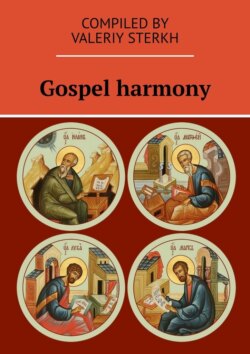Читать книгу Gospel harmony - Valeriy Sterkh - Страница 4
Part 1. Stating the facts
The Gospel of Mark
ОглавлениеThe Gospel of Mark was written around the middle of the 1st century. According to the tradition, it was written by John Mark (see Act 12:12), the nephew of Barnabas (see Col 4:10), who was one of the seventy apostles and a co-worker of Peter (see 1 Pet 5:13). It is regarded as the earliest of the four Gospels. It is the shortest of them all, and it was used as a source for writing the Gospels of Matthew and Luke.
«These are the words of the presbyter [Papias of Hierapolis]: „Mark was the interpreter of Peter; he accurately recorded everything that the Lord had said and done, but not in order, for he himself did not hear the Lord speak, neither did he walk with Him. Later he accompanied Peter who taught as he saw fit based on the circumstances, and did not necessarily relate the words of Christ in order. In recording everything the way he remembered it, Mark did not err against the truth. His only concern was not to miss or misrepresent anything“. That is what Papias said concerning Mark» (Eusebius of Caesarea. Church History, 3.39.15—16).
«Peter and Paul preached in Rome and founded a church there. After their departure, Mark, Peter’s disciple and interpreter, passed down to us in writing everything that Peter had taught» (Irenaeus of Lyons. Against Heresies, 3.1.1; compare Eusebius of Caesarea. Church History, 5.8).
«Mark, the disciple and the interpreter of Peter, wrote a short Gospel at the request of the fellowship in Rome, having recorded everything that he had heard from Peter. Clement [of Alexandria] in the sixth book of his „Brief Explanations“, as well as Papias, the bishop of Hierapolis, both testify that Peter approved of this work and declared that this Gospel should be read in all the churches. Peter also mentions Mark in his first epistle, metaphorically calling Rome Babylon: „The church that is at Babylon, elected together with you, saluteth you; and so doth Marcus my son“ [1 Pet 5:13]. Availing himself of the Gospel that he himself had compiled, Mark departed to Egypt, and, preaching Christianity in Alexandria, founded a church there, which became famous through its sound teaching and godliness, and was known for instructing all its adepts to follow the example of Christ. The highly-educated Jew by the name of Philo, witnessing the first church of Alexandria which was still Jewish by status, wrote a book about their way of life, confirming, according to Luke, that they had much in common with Jerusalem. Mark died in the eighth year of Nero’s reign [61/62 NE („from the New Era“)] and was buried in Alexandria. He was replaced by Annian» (Jerome of Stridon. On Famous Men, 8).
The Gospel of Mark is based on the apostle Peter’s memories. It is indicated in several passages. When writing about Jesus calling his disciples, Mark mentions Simon-Peter first (Mk 1:16), and refers to the disciples collectively «Simon and those who were with him» (Mk 1:36; compare Mk 16:7). Also, he mentions Peter first among the Twelve (Mk 3:16). The healing of Simon’s mother-in-law was one of the miracles of Jesus (Mk 1:29—31). Mark mentions some words and acts of Jesus that were witnessed only by a small number of the apostles, including Peter. For example, Jesus raising Jairus’ daughter from the dead (Mk 5:37—43), the transfiguration (Mk 9:2—10), and Jesus prophesying about the end of the age (Mk 13). Mark also mentions that it was Peter who noticed the withered fig tree (Mk 11:21). Describing what happened in Gethsemane, Mark talks about Peter’s denial (Mk 14).
Many biblical scholars agree that in the account of Jesus’ arrest, Mark describes himself as the young man in a linen cloth: «Now a certain young man followed Him, having a linen cloth thrown around his naked body. And the young men laid hold of him, and he left the linen cloth and fled from them naked» (Mk 14:51—52).
